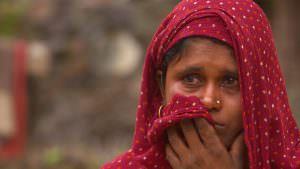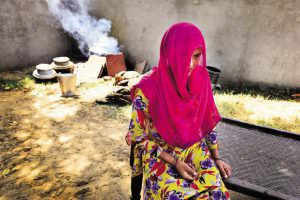Haryana is considered an economically developed region of India with growing investments in agricultural and manufacturing industries. However, it remains one of the most backward states in terms of gender parity. According to the Census of 2011, the state of Haryana reveals a devastating picture of the status of women and young girls in terms of literacy which is 85.38% for males and 66.77% for females, with the last recorded work participation rate to be 68.22% for males and 37.31 for females (Census 2001).
The state still faces a stark inequality in terms of sex ratio which is 879 females per 1000 males (Census 2011). In the beginning of this year, it was reported by various dailies like Times of India and Hindustan Times that the sex ratio of Haryana has touched the 900 mark for the first time. This development was not only celebrated but accredited to the Prime Minister’s campaign Beti Bachao Beti Padhao. However, this does not discount the fact that the state fails to provide or improve the dilapidated condition of women. Haryana was recorded as having the highest number of gang rape cases in the country after Delhi in 2016 and highest rates of dowry deaths after Uttar Pradesh and Bihar.
This opens numerous challenges for a feminist analysis to engage with the status of women in Haryana. The population remains majorly dependent on an agrarian economy for survival. The occupation in maintaining and producing agricultural land is majorly dominated by men of the household.
Further, the role of women working in the fields is diminished or subjected to surveillance by patriarchal heads. Thus, the movement of women become restricted to the domestic sphere which binds them into a trap of getting no recognition or value for their labour and normalises their oppression within the agrarian society. This split of public and private reproduces women’s oppression into all social spheres.
the role of women working in the fields is diminished or subjected to surveillance by patriarchal heads.
However, the position of women is reflected in the unsolved cases of bride trafficking in Haryana. Many families in Haryana look for brides outside their social, cultural ambit and become deeply involved in bride trafficking of young women from poorest parts of the country including the states of Assam, West Bengal, Jharkhand, among others. The issue has been raised by foreign media and national dailies, but the impact of it has been meagre and limited.
Women as Commodities – Cases of Bride Trafficking
Women belonging to the poorest parts of the country are abducted, misled, raped and coerced into being sold off as brides for a meagre amount of money in Haryana. The shocking stories of women reveal the larger patriarchal violence and abuse they are subjected to in this heinous form of trafficking.
Sanjeeda was abducted at the age of ten while playing with a female friend near her home in Assam and made to do agricultural work for four years of captivity. Due to lack of help and grotesque captivity, she was sold into marriage at the age of fifteen. Her family found her, while she was three months and pregnant and witnessed the way she was treated in her conjugal home.
Due to her marital ‘obligations’, Sanjeeda could not leave the house and move back to her home in Assam. Her husband agreed to have married a woman outside of the state due to parental ‘pressure’. He explained that poverty became of the reasons to look for brides outside their village. As nobody would want to marry their daughter into a poor family, so his parents ‘arranged’ for a bride for him.
Also Read: Is Ghoonghat The Identity Of Haryana? Patriarchal Control Over A Woman’s Body & Sexuality
He refused to divulge into details as his parents did not share much information about Sanjeeda’s background and got him married to her.

Sanjeeda recounts her experience of being trafficked. Image credit: Aljazeera
Sanjeeda started working with a local NGO that aims to help, rescue, provide legal aid, discuss problems and deal with traumatic experiences of other trafficked women. However, as she is determined to help other women, she finds it hard to come out of her own marital captivity and aims to educate, provide a better future to her daughters.
Majeeda, a mother of four, lost her daughter, Jameeran after the death of her husband. Jameeran went missing at the age of sixteen, when she was abducted from the nearby market in a small village of Assam. Majeeda was informed about her daughter’s place in Haryana. She lodged a complaint at the police station and was asked to pay fifty thousand rupees by the police officials.
A few days later, Jameeran informed Majeeda about her marriage and told her about the impossibility of her to get in touch or come back and meet her family in Assam. Later, when Majeeda was taken with Al Jazeera’s correspondent and Haryana police rescue team to meet her daughter. She broke down after seeing Jameeran and asked her to come back home. Jameeran was not taken aback but upset with her mother’s attempt of getting help from the police and rescuing her. She was not only ‘embarrassed’ but refused to come back with her.
On the other side, Jameeran’s husband claimed to have found Jameeran on a railway station with her uncle and aunt, (who Jameeran mentioned as her traffickers) and agreed to have paid two thousand five hundred rupees for her ‘expenses’. He claims to have married Jameeran with her consent and urges to not ‘leave’ her even for a day. However, Majeeda refuses to believe the story of their alliance. She is shattered by her daughter’s refusal and unwillingness to come back home with her mother. View her story here.

Priyanka Prashar. Image credit: Livemint
Priyanka Prashar, a twenty three old belongs to Banarhat, Siliguri was sold off to a forty five year old widower and father of three in Karnal district of Haryana. Priyanka faced a life of extreme poverty as child and suffered from malnutrition and other health issues. Her mausa (uncle), Rajendra Pal advised the family to see a godman in Haryana who could help her with recurring health problems.
Priyanka’s mother and brother persisted and so does Priyanka as she sensed that she could be subjected to grave danger because of being a young woman. Rajendra Pal finally took the family to Haryana and after locking Priyanka’s mother and brother in a room, raped her in front of his wife (who tried to convince her to do as the uncle asks). After being sold off, Priyanka tried to escape and hide in the fields, but was later found by her ‘husband’s’ family. Now she does all the household and fieldwork and gets mistreated by the family.
Women’s labour and body
In the many cases of bride trafficking, women’s exploitation is an indirect impact of agrarian class structure which drives their families into extreme poverty. Women are seen as commodities to be exchanged and a form of cheap labour to be exploited under a patriarchal setup. In the case of Majeeda’s daughter Jameeran, her husband spoke for her ‘impossibility’ to move out of the house or ‘leave’ him.
Women are sold off to men and forced to marry strangers they are seen as ‘incapable’ to move out of the marital contract which reproduces sexual division of labour among men and women. All the cases show that marriage as an institution rationalizes and institutionalizes male authority over women’s labour and body. It not only confines women to the domestic sphere but legitimises social restrictions on a woman’s ‘obligations towards her husband and her movement without his consent.
Many families in Haryana look for brides outside their social, cultural ambit and become deeply involved in bride trafficking.
In the case of Jameeran, accepted the patriarchal ideology enforced in a marriage and her marital obligations towards her husband. Majeeda, on the other hand, a widowed mother of four tried to convince Jameeran to resist her familial confinement and get herself educated. Majeeda refused to accept Jameeran husband’s claims and asked her to resist it as well.
Sanjeeda, even though determined to help other trafficked women and resist this practice, fails to question violent patriarchal practices embedded within the institution of marriage. She shows her wish to educate her daughters and see them settled.
Priyanka was subjected to extreme forms of patriarchal violence in her own family, tried to raise her voice, inform her mother about the problems she is going to face because of being a young woman, cried in front of her aunt while she was raped by her uncle, Rajendra Pal and escape from where she was sold.
All the women who are subjected to bride trafficking are seen as cheap commodities to be exchanged or sold off and to be economically dependent on their husbands. The capital produced through women’s labour is not only considered cheap but holds a collective/ familial value. All the cases raise a crucial fact regarding the way women’s bodies are disciplined and defiled under patriarchal oppression within and outside familial sphere. In Priyanka’s case, her body was already a subject of her uncle’s gaze and disciplined by the women in family, just as her mausi asked her not to cry, raise her voice and just give in.
Thus, a woman’s body is disciplined and violated under patriarchal authority. A woman’s labour is devalued and appropriated by male heads. The institution of marriage institutionalizes women’s oppression. Further, women are sold off as commodities in small villages of Haryana. It is relevant to question whether a woman’s body belongs to her and can be looked beyond her gender identity. All the women who are subjected to human trafficking raise a feminist concern of moving beyond a patriarchal and capitalist relation to one’s labour and body.
Also Read: Unpaid Domestic Labour And The Invisibilisation Of Women’s Work
References
- India’s Slave Brides, Al Jazeera
Featured Image Credit: Youth Ki Awaaz
About the author(s)
I am still confused about calling myself a radical feminist. A sluggish writer. I am more interested in reading about politics, colonial history, and stories of resistance to dominant power structures. I believe that patriarchy screwed up everyone’s life. I have an undying love for western Marxist and feminist theories.





This was a very interesting read. Very well researched. Keep up the goid work, Deeksha.